The term ‘entrepreneurship’ was first coined in the 17th century. Since then, entrepreneurship— the practice of forming a new business — has become synonymous with innovation, wide-scale value creation, and prosperity.
As millions embrace the digital revolution, global entrepreneurship levels are expected to surge. At Whop, we've compiled over 100 entrepreneurship statistics you need to know for 2024. Read on to discover key trends, insights, and more.
State of Entrepreneurship Statistics
According to a 2024 Global Entrepreneurship Monitor (GEM) report, levels of entrepreneurial activity are on the rise globally1.
51% of the 79 economies that participated in GEM research between 2001 and 2023 have shown a significant increase in early-stage entrepreneurship.
- In 22% of the economies, entrepreneurship levels more than doubled.
- In 23% of the economies, entrepreneurship levels decreased significantly.
- In 1% of the economies, entrepreneurship levels halved.
While the report found that levels of entrepreneurial activity were highly variable across all regions and income groups, levels of entrepreneurial activity were highest in Latin America and the Caribbean region.
There, all five of the highest rates of adults started and ran new businesses. Notably, Panama had a level of 31% while Mexico had a level of 17%.
Lower-income economies had higher numbers of new startups, particularly in the consumer services sector, where entry requirements were generally less demanding.
71% of economies in the lowest income group had over 66% of new startups in consumer services, compared to just one economy in the middle and higher income groups combined.
Globally, startup activity in 2023 sat at 12.7% for men and 10.7% for women2.
Additionally, the majority of entrepreneurial activity was observed in the Wholesale/Retail sector for both women (49%) and men (40%).
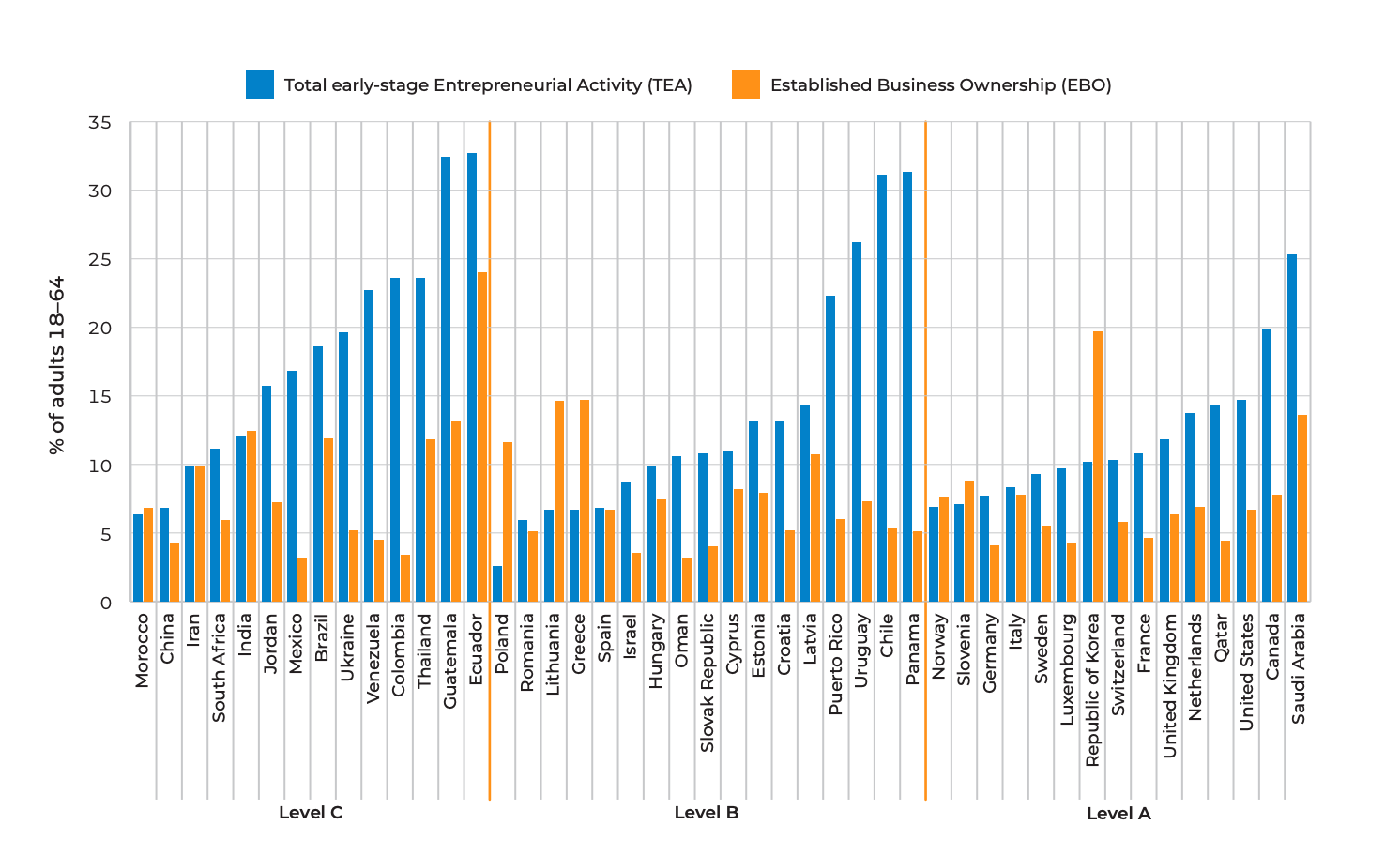
As a testament to the power and scale of entrepreneurship, there were approximately 359 million companies worldwide in 20233.
This represents a significant increase from 2020 when there were 328 million companies.
- 358 million of these or over 90% were SMEs, employing 250 or fewer employees and contributing over 70% to the global GDP and employment.
- Over 150 million were startups disrupting industries and changing the world.
- 377,000 were large companies that employed 250 or more people worldwide.
- Over 1,242 were unicorn companies4 scaling value creation in key industries such as Health, Finance, and Tech.
In global research conducted by Amway, 60% of individuals were interested in starting their own business5 in 2024.
Compared with pre-pandemic data, global interest in entrepreneurship increased across 15 markets.
- 58% were interested in owning their own business.
- 51% viewed financial independence or stability as the top benefit.
- 40% expressed a business interest in a sharing economy, up from 35% in 2019.
- 37% had a business or planned to start one within the next year.
The research also revealed that 59% of individuals knew someone engaged in entrepreneurial activities like freelancing, social selling, or direct selling.
This made entrepreneurship less daunting and more desirable.
Moreover, global sentiments toward entrepreneurship were stronger than ever with 96% of individuals having positive feelings about other people pursuing side income.
- 54% saw entrepreneurship as a great way for people to use their talents.
- 67% viewed having their own business as a desirable opportunity after seeing someone they knew start one, up from 58% in 2019.
Entrepreneurship Success Statistics
While entrepreneurship success rates vary based on factors such as the business type and industry, business success rates were generally around 10% to 20% over the long term.
- 20% of new businesses failed within the first two years.
- 45% of new business failed within five years.
- 65% failed within ten years.
Based on a post-mortem of hundreds of entrepreneurial ventures, 42% of businesses failed due to not having a market.
Additionally:
- 29% failed due to running out of funding.
- 23% failed as a result of not having the right team.
- 19% were out-competed.
- 18% failed due to pricing and cost issues.
After 20 years of studying what makes entrepreneurs successful, research revealed that successful entrepreneurs were 30% more likely to think big and 40% more likely to take initiative6.
They were also:
- 40% more motivated to turn their ideas into action
- 43% more motivated by money and ROI than the rest of the population.
The same research also found that first-time entrepreneurs had an 18% chance of success.
- However, after failing, learning valuable lessons, and gaining experience, the odds increased to 20%.
- And while 20% of startups fail in their first year, the rates of entrepreneurial failure have fallen by 30% since 1977.
A 2023 study found that successful entrepreneurs were middle-aged, with a mean founder age of 45 in the 1% of fastest-growing new ventures7.
The findings remained consistent when considering high-tech sectors, entrepreneurial hubs, and successful firm exits. Additionally, prior experience in an industry was found to be a predictor of higher entrepreneurial success.
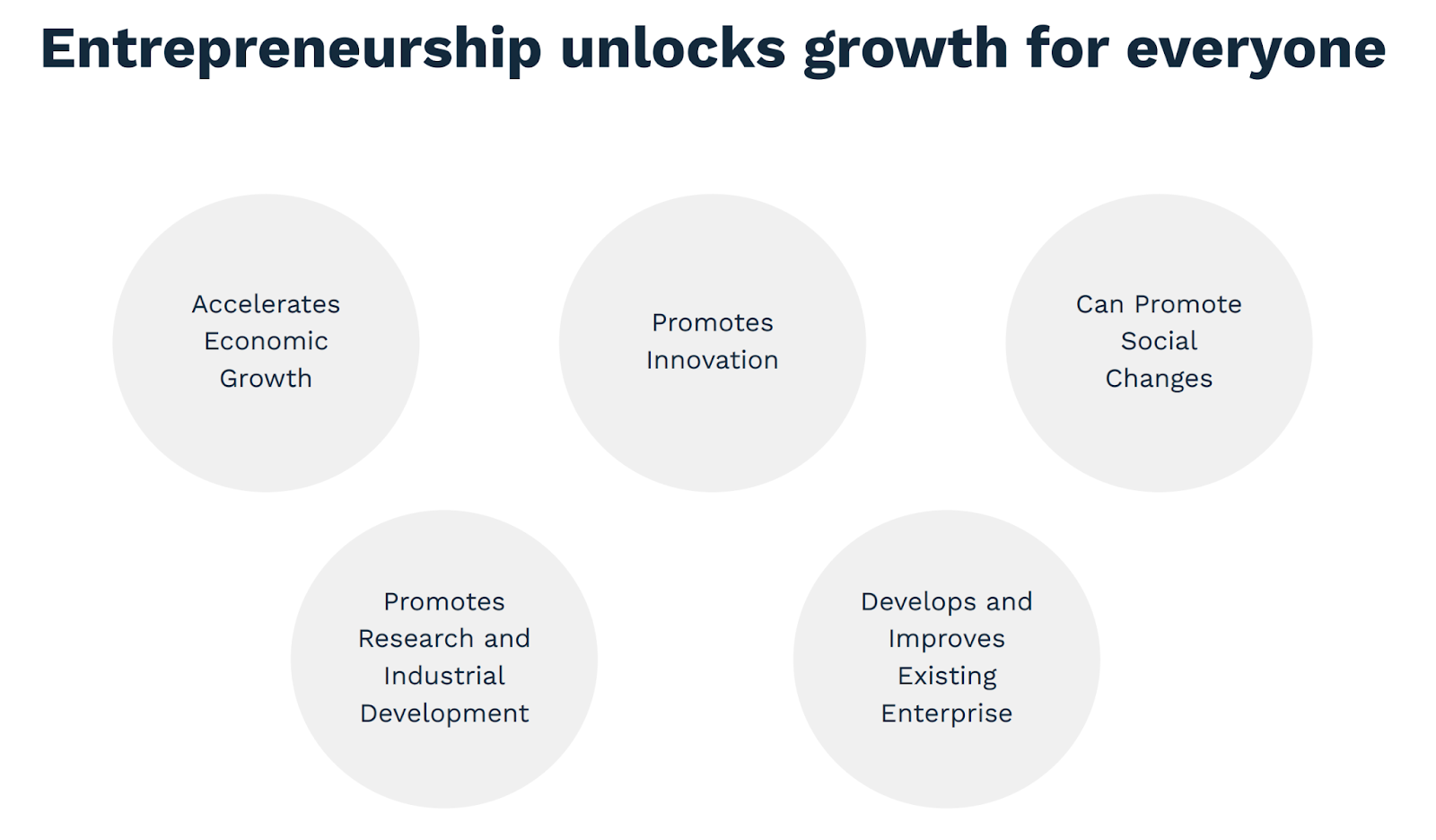
In terms of whether entrepreneurship can be taught, the previously mentioned GEM report found that entrepreneurial education in most economies was rated as poor.
Entrepreneurship education earned the lowest scores across the 13 Entrepreneurial Framework Conditions in 64% of the economies studied. Additionally, a survey revealed that entrepreneurial education was satisfactory or better in just 10% of economies.
Consequently, according to HBR, progressive business schools have pioneered new teaching models designed to teach entrepreneurship more effectively by focusing on “effectuation,” or leveraging existing resources to take action8.
As per a 2023 index measuring the 12 entrepreneurial environment conditions (EFCs) on a scale of 0 to 10 points (with 0 being completely insufficient and 10 being completely sufficient), the UAE ranked as the best country in the world to start a business with an index score of 7.7 out of 109.
This was followed by:
- India with a score of 6.6
- Saudi Arabia with a score of 6.3
- Qatar with a score of 6
Entrepreneurship Challenges Statistics
40% of adults were apprehensive about becoming entrepreneurs due to fear of failure.
Fear of failure remains a key obstacle to entrepreneurship, especially for women. In 2024, the biggest perception gap was in the UK, where 63% of women vs 44% of men seeing good opportunities would not start a business due to fear of failure.
Women represented 25% of high-growth entrepreneurs globally in 2024.
In North America, they accounted for 40%, while they accounted for over 33% in low-income countries.
While levels of female entrepreneurship continue to increase, 76% of experts in most economies in a GEM report still rated social support for women entrepreneurs as unsatisfactory.
In 55% of economies studied, women entrepreneurs’ access to resources compared to that of men was rated as satisfactory.
Notably, the five economies most supportive of female entrepreneurs were:
- UAE
- India
- Qatar
- Sweden
- Norway
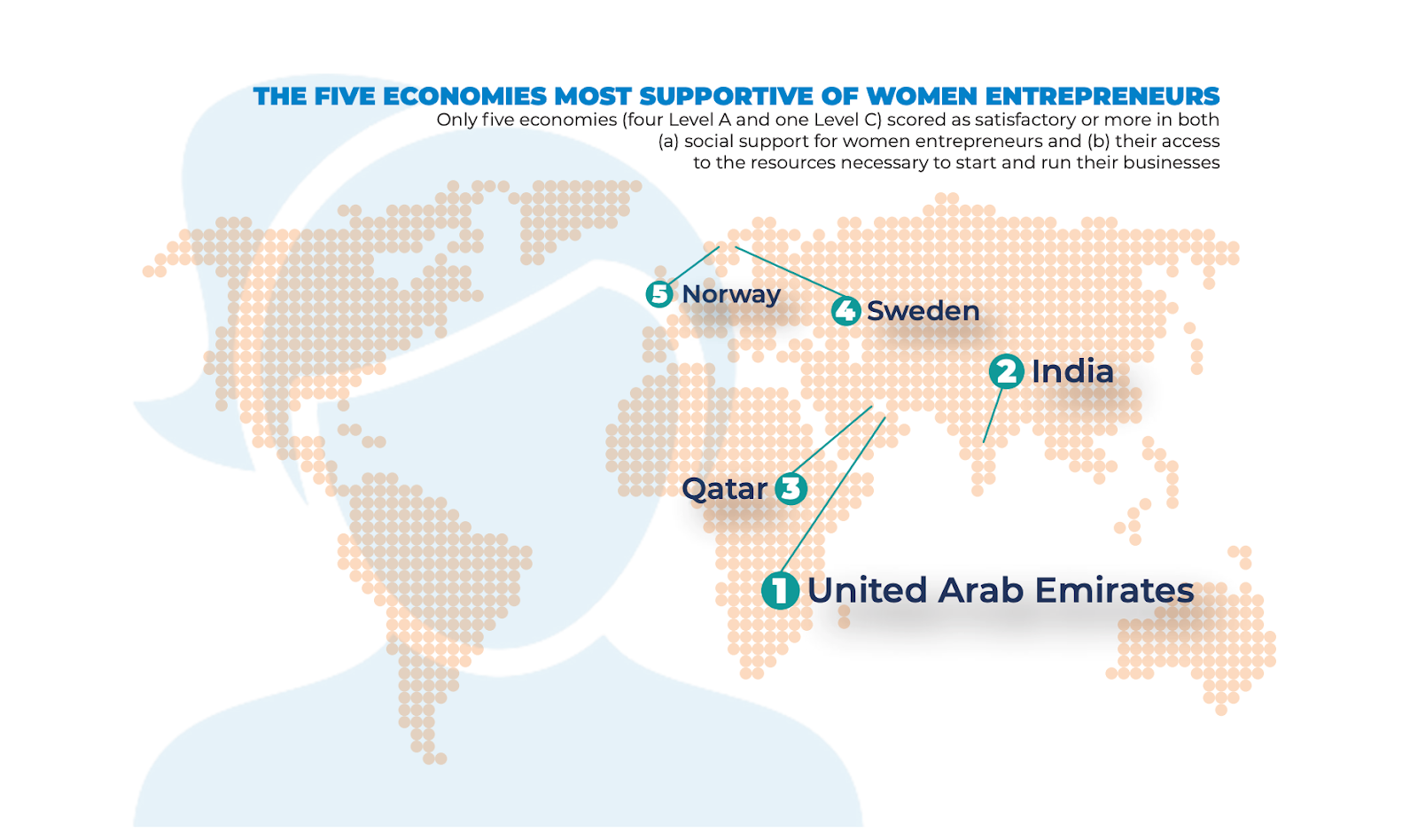
A major entrepreneurship challenge was financing with 54% of entrepreneurs citing it as a persistent struggle in 202410.
Other challenges cited included:
- Maintaining work-life balance - 39%
- Accessing financing - 22%
- Scaling - 20%
- Recruiting and retaining talent - 20%
- Budgeting - 19%
- Earning recurring revenue -13%
Additionally, 68% of entrepreneurs in the startup stage considered the first $100,000 as the hardest annual recurring revenue (ARR) milestone to hit.
This was also the case for:
- 30% of entrepreneurs in the growth or expansion phase
- 28% in the mature or steady stage
- 44% in the winding down stage
Meanwhile, for entrepreneurs with more established businesses, the hardest ARR milestone to hit was between $101,000-$500,000.
This was also the case for:
- 42% of entrepreneurs in the growth or expansion phase
- 45% in the mature or steady stage
- 44% in the winding down stage
A Kauffman study found that 70% of entrepreneurial ventures experienced financial challenges throughout the start-up process11.
- 76% of entrepreneurs also experienced challenges with non-financial resources such as finding support and time to pursue their ideas.
- 71% also faced challenges related to business operations.
- 55% had challenges reaching customers
- 51% found market and economic conditions challenging.
In the study, established entrepreneurial ventures also faced challenges, though to a lesser extent, with 64% citing a lack of nonfinancial resources as challenging.
- 58% faced financial challenges
- 54% faced unfavorable market or economic conditions
- 52% had difficulty reaching customers
The same study found that compared to established entrepreneurial ventures, 22% of start-ups struggled to find support, advice, or role models.
21% said they also faced challenges getting support from family and friends, while 13% had difficulty finding professional support.
Consequently, 61% of entrepreneurs were more likely to seek out advice and support from family members or acquaintances (55%) than they were to consult with established business leaders (20%) or professionals such as lawyers and accountants (24%).
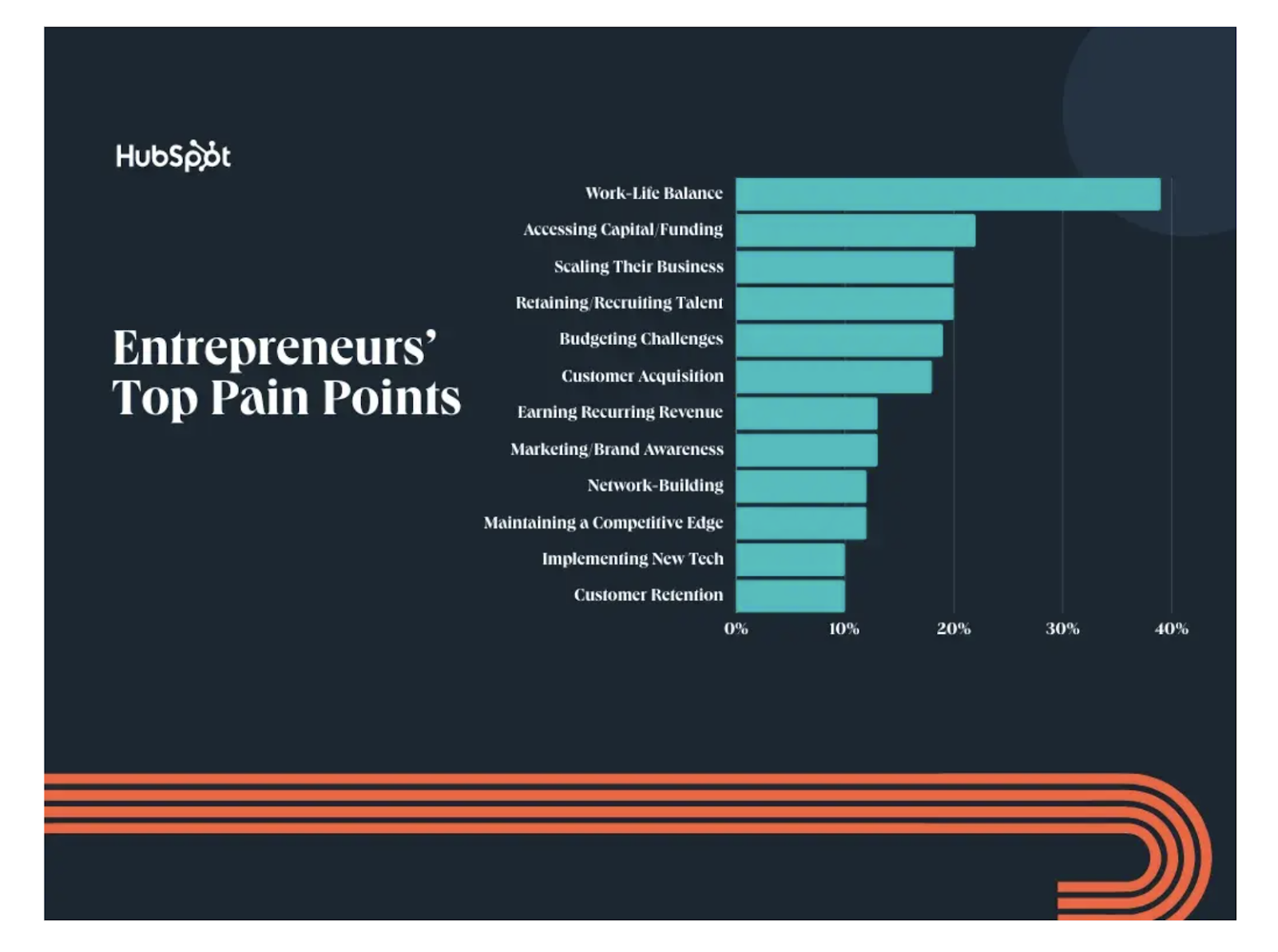
However, over 10% of established businesses cited a lack of access to support as a key challenge.
The most common business operations challenge experienced by startups was simply not knowing where to start (58%).
On the other hand, 23% of established businesses said their biggest operational challenge was doing their taxes.
35% of individuals actively engaged in launching an entrepreneurial venture ultimately decided to stop, primarily due to a lack of financial resources.
Similarly, among former business owners who ended up closing down, 64% cited challenges accessing capital as the main reason they closed their business.
Entrepreneurship Funding Statistics
As of 2024, 74% of entrepreneurs used personal funds to support their entrepreneurial ventures
Meanwhile:
- 27% used business loans
- 19% used credit cards
- 18% borrowed or received donations from friends and family
- 14% sought out funding from investors and private equity firms
- 4% used crowdfunding
65% of new entrepreneurial ventures relied on personal or family savings to cover start-up costs.
Business loans came in second at 17%, other sources included:
- Credit cards (Personal and Business) - 17%
- Family or equity loans - 5.5%
- Venture capital investment - 1%
40% of entrepreneurs identified raising capital for entrepreneurial ventures as their key barrier, down from 45% in 2019.
Additionally, 39% felt they had the necessary resources to start a business, up from 35% in 2019.
According to Crunchbase data, global venture funding hit $66 billion in the first quarter of 2024, down 20% from 202312.
Funding in the quarter was the second-lowest on record for global startup funding since 2018. Overall, global funding fell 61% from 2021 to 2023.
The data also found that AI and Healthcare took the lead in terms of investment in Q1 2024.
- The Healthcare and biotech sector raised $15.7 billion or 24% of all global funding.
- The AI sector raised $11.4 billion or 17% of global funding.
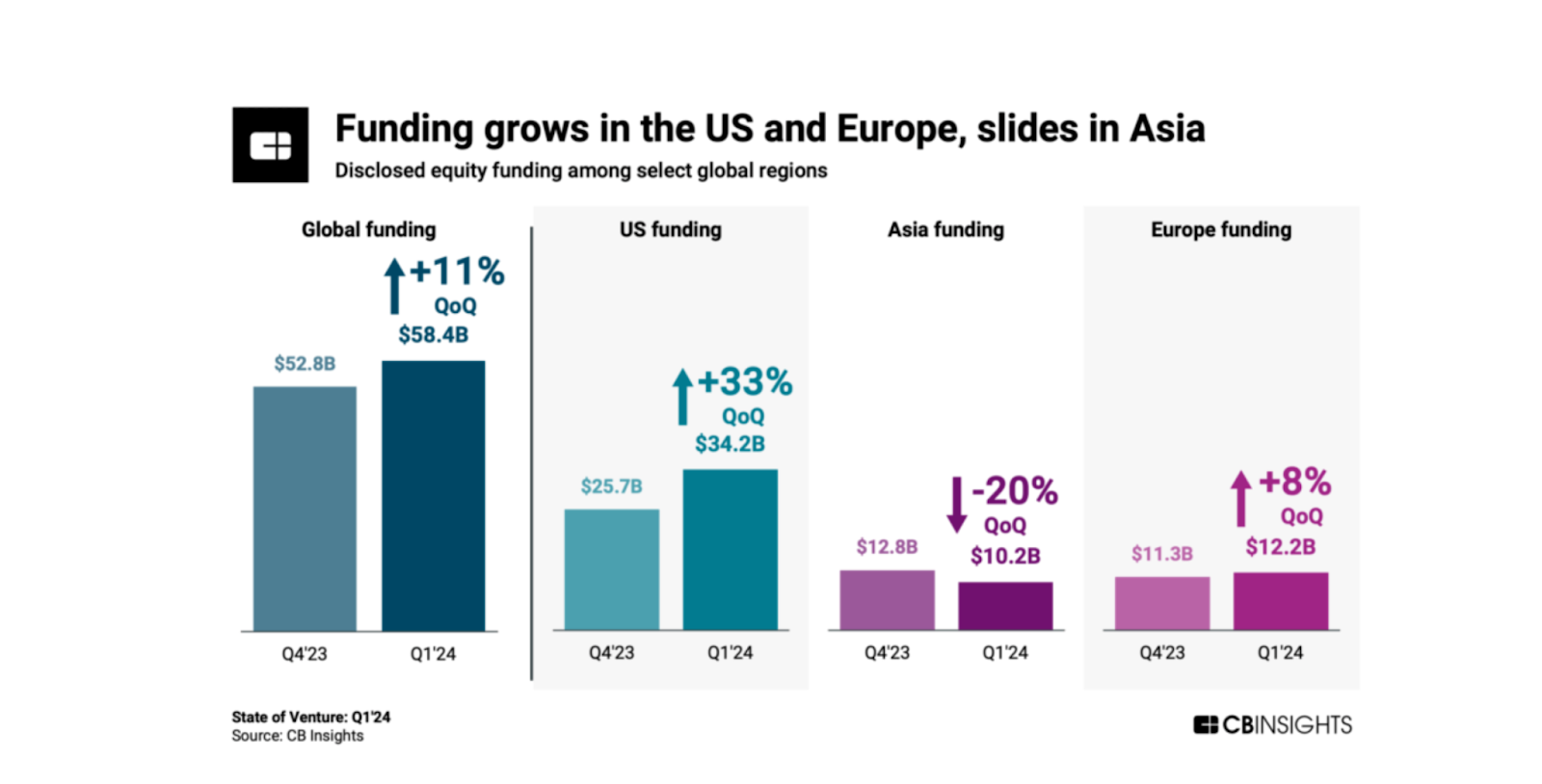
Seed companies raised over $7 billion, down $1 billion from 2023.
Meanwhile, early-stage funding was $29.5 billion, up 6% from 2023. Late-stage funding was also $29.5 billion, down 36% year over year.
Meanwhile, 2024 CB insights data found that global funding was up 11% quarter over quarter13.
In the US, venture funding increased by 33% quarter over quarter. In Europe, funding increased by 8% however, funding in Asia fell by 20%.
90% of new entrepreneurial ventures needed capital at start-up in the US in 2023.
Capital requirements also varied across industry groups, ranging from:
- 80% of ventures in the utilities industry
- 95% in the accommodation and food services industry.
- 93% in the retail industry
- 89% in the information industry
These findings have remained consistent since 2015, with 48% of all entrepreneurial ventures needing less than $50,000 and 19% needing $100,000 or more.
In 2023, the SBA provided $52.4 billion in startup, growth, and recovery capital14.
This represented a 45% increase in funding since 2021 and was driven primarily by greater funding to minority and typically underserved business owners.
Entrepreneur Statistics
As of 2024, there were over 600 million entrepreneurs worldwide, up from 582 million in 202015.
An entrepreneur is anyone who starts a business and takes on financial and other risks to turn a profit. These enterprising individuals now account for over 8% of the world’s population.
According to the previously mentioned GEM report:
- Men were more likely than women to be entrepreneurs and own established businesses.
- Younger people (aged 18-34) were more likely to be entrepreneurs and own established businesses.
- Graduates were more likely than non-graduates to be entrepreneurs starting or running a new business.
- Those whose income increased in 2023 were more likely to engage in entrepreneurial activity, while the opposite was true for those whose income decreased.
Entrepreneurs tended to be highly educated in 2024, with 44% holding a Bachelor’s Degree, followed by 27% with a Master’s degree16.
- 15% had a High School Diploma/GED
- 11% had an associate degree
- 4% had a Doctorate
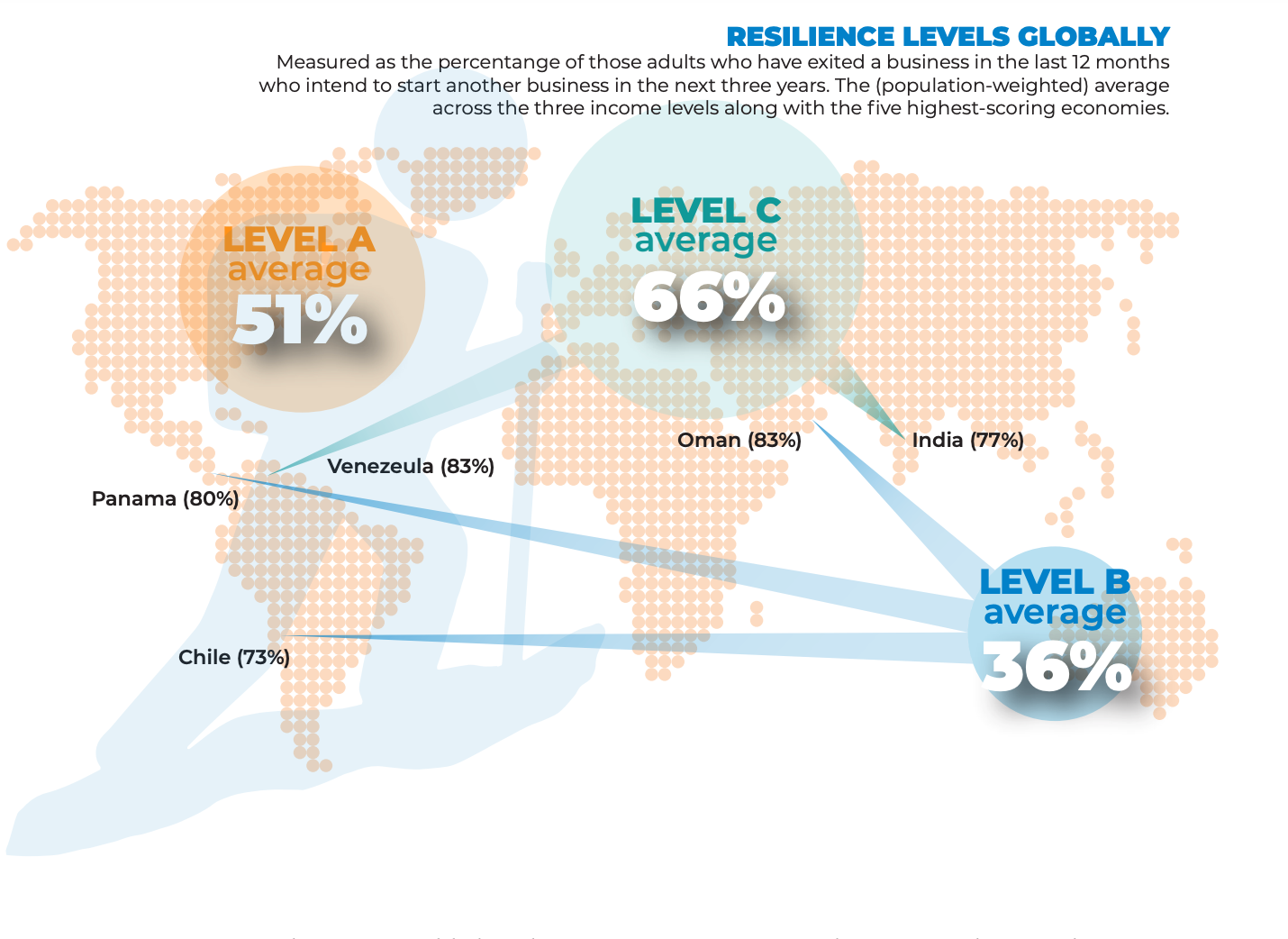
Entrepreneurs were found to have high levels of resilience. In 70% of economies studied by the GEM, those exiting a business were over 2x likely to start a new business in the next 3 years versus the general public.
- In level A economies (GDP per capita of over $50,000) resilience levels were 51%.
- In level B economies (GDP per capita between $25,000 and $50,000) resilience levels were 36%.
- In level C economies (GDP per capita of less than $25,000) resilience levels were 66%.
A 2023 HSBC report found that 54% of entrepreneurs were first-generation, while 46% came from a family business background17.
This held true across the nine markets studied in the research. It was also revealed that 25% were working or worked in their family business. Meanwhile, 21% came from family businesses but ran separate companies.
The report found that entrepreneurs were internationally minded and connected with 46% living across more than one market.
- 75% conducted business with international markets and 13% planned to expand their businesses into additional markets.
- The main business advantage entrepreneurs experienced abroad was operational efficiency at 44%.
- Other advantages included economic conditions (43%) and appropriate technology 42%.
The report also found that 43% of entrepreneurs were not only in search of business opportunities abroad but also international and real estate investments (41%).
Other priorities included:
- Education for their children - 39%
- Access to international investments/portfolios - 38%
- Buying property for personal use - 34%
Additionally, 60% of global entrepreneurs expected Europe to become more of a focus for their business and family.
- 45% selected North America
- 32% selected Asia
- 25% selected South America
The percentage of entrepreneurs who started an entrepreneurial venture as a side hustle increased from 27% in 2022 to 44% in 202318.
25% of entrepreneurs worked full-time day jobs while 19% worked part-time jobs.
In addition, younger individuals were more likely to start a business as a side hustle, with 49% of entrepreneurs working for someone else while venturing into entrepreneurship.
This is compared to:
- 42% of the 35-44 age group
- 43% of the 45-54 age group
- 38% of the 55 or older age group
Entrepreneur Sentiments Statistics
37% of entrepreneurs were optimistic about higher sales or ARR in 2024, with 23% expecting a similar or steady ARR throughout the year.
In addition, 23% expected to secure new funding or investments, while 6% expected to downsize, cut their budgets, or shut down entirely.
70% of entrepreneurs in 2024 attributed their motivation for starting a business to a career or lifestyle change.
Meanwhile, 45% of entrepreneurs chose entrepreneurship because they wanted to be their own boss.
In addition:
- 26% wanted to follow their passion.
- 16% wanted to earn more income.
- 9% said it was due to a life transition.
45% of entrepreneurs expected to make more income compared to the salaries at their last full-time job19. Of those who went into entrepreneurship to make more money, 73% were successful in making more money.
- 68% went on to earn more than their previous role, within 2 years.
- 77% who worked in the same industry made more money than their last job.
- 57% who worked in a different industry made more than their last job.
In the previously mentioned HSBC report, over 33% of entrepreneurs considered exiting within the next five years.
This included 46% of entrepreneurs aged 56 and older and 34% of those aged 18 to 35.
The most popular exit was keeping the business in the family with 52% of entrepreneurs intending to transfer their business to the next generation. This rose to 58% for those with investable assets of over $10 million.
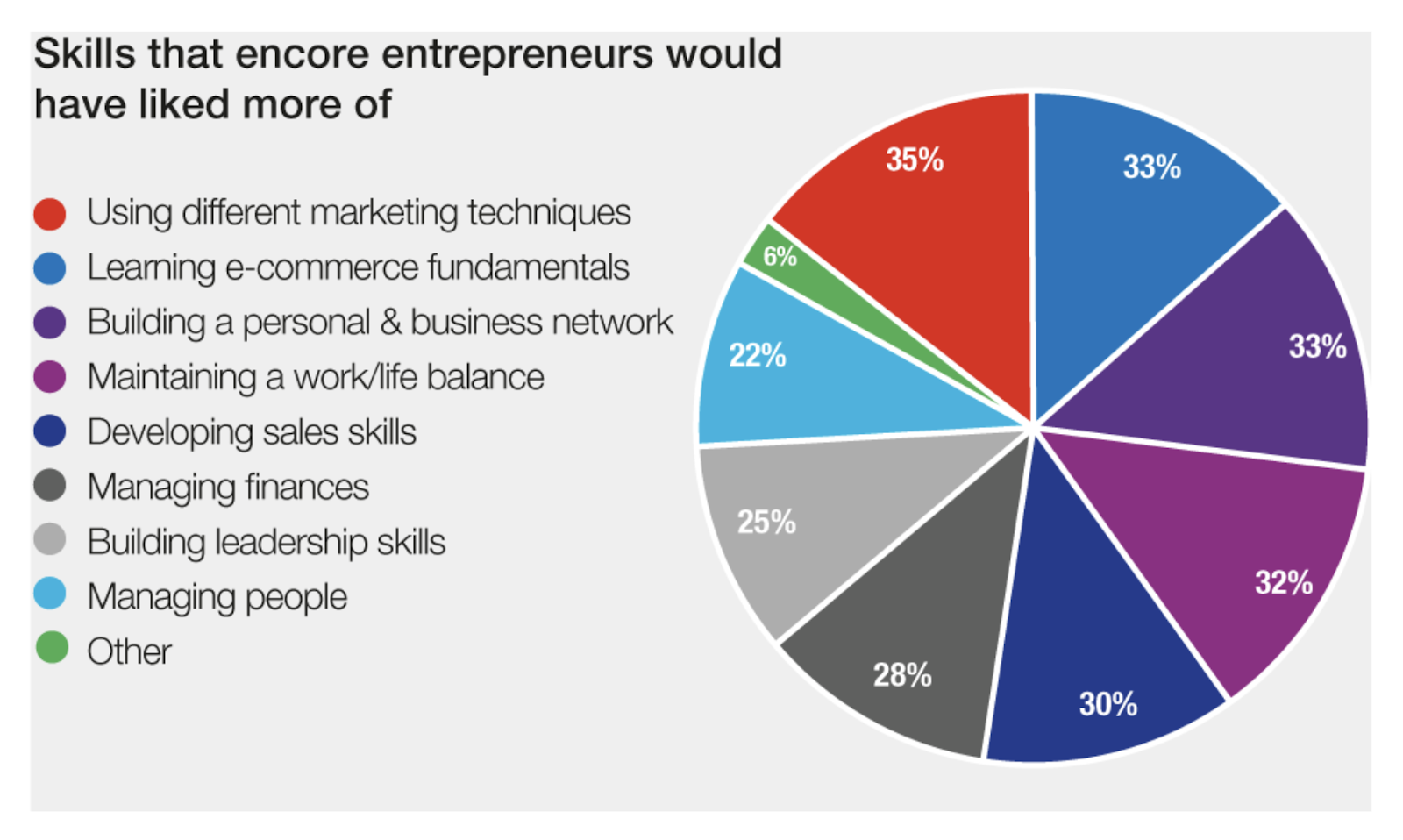
70% of entrepreneurs who planned to hand down their businesses believed next-generation readiness was the top factor in deciding when to exit.
- 44% had an age in mind for their exit.
- 38% said they would exit when they no longer enjoyed their role.
50% of former entrepreneurs recommended that those planning an exit have a full understanding of the financial value of their company.
A further 47% recommended having a full understanding of the process, while 42% recommended starting preparations as early as possible.
Post-exit, a majority of entrepreneurs (53%) planned to stay in business.
- 29% said they would invest in or start another business.
- 27% would pursue personal interests.
- 24% would help other businesses.
60% of entrepreneurs believed that entrepreneurship was a way of life.
2022 research revealed that Individuals who spent 2 years as entrepreneurs were more likely to:
- Develop natural problem-solving skills
- See problems as opportunities
- Develop resilience
- Make an impact in the lives of others
- Adapt to change faster
The top 3 factors entrepreneurs considered critical to success were having a great team (98%), communication (96%), and problem-solving ability (96%).
Other factors included systemizing business processes, prioritizing purpose, and internal grit.
Marketing techniques (35%) ecommerce fundamentals (33%) and networking (33%) were the key skills new entrepreneurs wish they had more of.
Other key skills included:
- Work-life Balance - 32%
- Sales Tactics - 30%
- Financial Management - 28%
- Leadership - 25%
- People Management - 22%
Entrepreneur Tactics Statistics
Leveraging the boom in technology, 40% of entrepreneurs in Chile, Guatemala, Italy, Luxembourg, Mexico, Panama, and Sweden introduced innovative new products or services in 2024.
The majority of new entrepreneurs in other economies (60%) chose to replicate existing goods and services using familiar processes and technologies.
At least 50% of new entrepreneurs identified a Sustainable Development Goal (SDG) as a priority in 76% of the economies studied in the GEM report.
New entrepreneurs in 80% of economies prioritized good environmental or sustainability practices above economic performance.
Plus, more than 50% of new entrepreneurs took active steps to reduce the environmental impact of their new business in 62% of economies.
Meanwhile, more than 50% of established entrepreneurs in 80% of economies took steps to minimize environmental impacts.
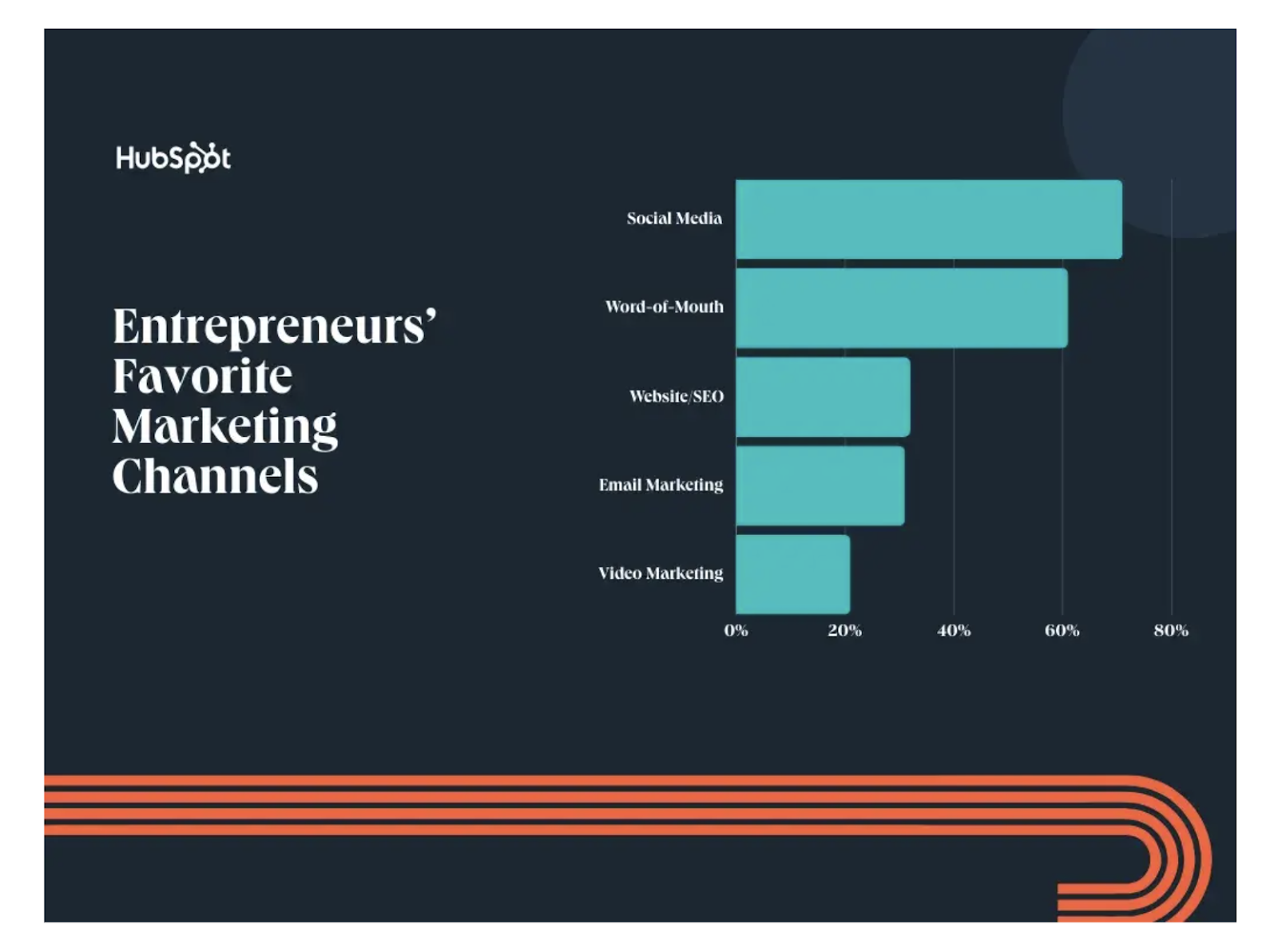
In terms of hiring, employee referrals were the most popular hiring method among entrepreneurs with 77% using this tactic to find new talent. Additionally:
- 37% of entrepreneurs used social media
- 31% used job sites and job boards
- 12% used recruiting agencies
- 9% used hiring events
- 2% used higher education programs
The opportunities entrepreneurs considered worth pursuing in 2024 and beyond included customer acquisition( 57%) and hiring more talent (29%).
When asked about other priorities:
- 29% said increasing brand awareness
- 23% said implementing new technology
- 22% said sourcing financing or capital
Regarding marketing channels, a majority of entrepreneurs (71%) selected social media as their favorite. This was followed by word of mouth at 61%.
Other marketing channels included:
- Maintaining an active website and SEO - 32%
- Email marketing - 31%
- Video marketing - 21%
With regards to the key support factors entrepreneurs used to fuel success, 79% relied on personal development and habits.
This was followed by technology at 56%, partners at 51%, and communities at 49%.
Gen Z Entrepreneurship Statistics
A 2023 Square report found that Gen Z was the most entrepreneurial generation yet, with 54% of respondents reporting that they planned to start a business20.
Additionally:
- 90% of Gen Zers said the economic uncertainty of the past few years had affected their decision to start their own business.
- 62% had been running a business for 2 years or less.
- A further 73% of Gen Z entrepreneurs reported that their businesses were their main source of income.
In the report, 72% of Gen Z entrepreneurs believed their generation had fewer economic opportunities than previous generations.
Yet, 84% still planned to venture into entrepreneurship in the next five years.
67% of Gen Z entrepreneurs came from non-traditional routes by foregoing college to pursue dreams of being an entrepreneur.
In terms of how they defined success:
- 46% wanted to be their own boss.
- 43% sought out scheduling flexibility.
- 42% wanted to achieve a positive work-life balance.
- 40% wanted to make a difference in their community.
The same report found that 74% of Gen Z entrepreneurs were personally invested in their own success, with 45% using their own funds to start their businesses.
53% of female entrepreneurs compared to 38% of males tapped into their own funds as start-up capital.
Across the board, only 16% of Gen Z entrepreneurs took loans from traditional lenders like banks.
Meanwhile, 12% received loans from family and friends.
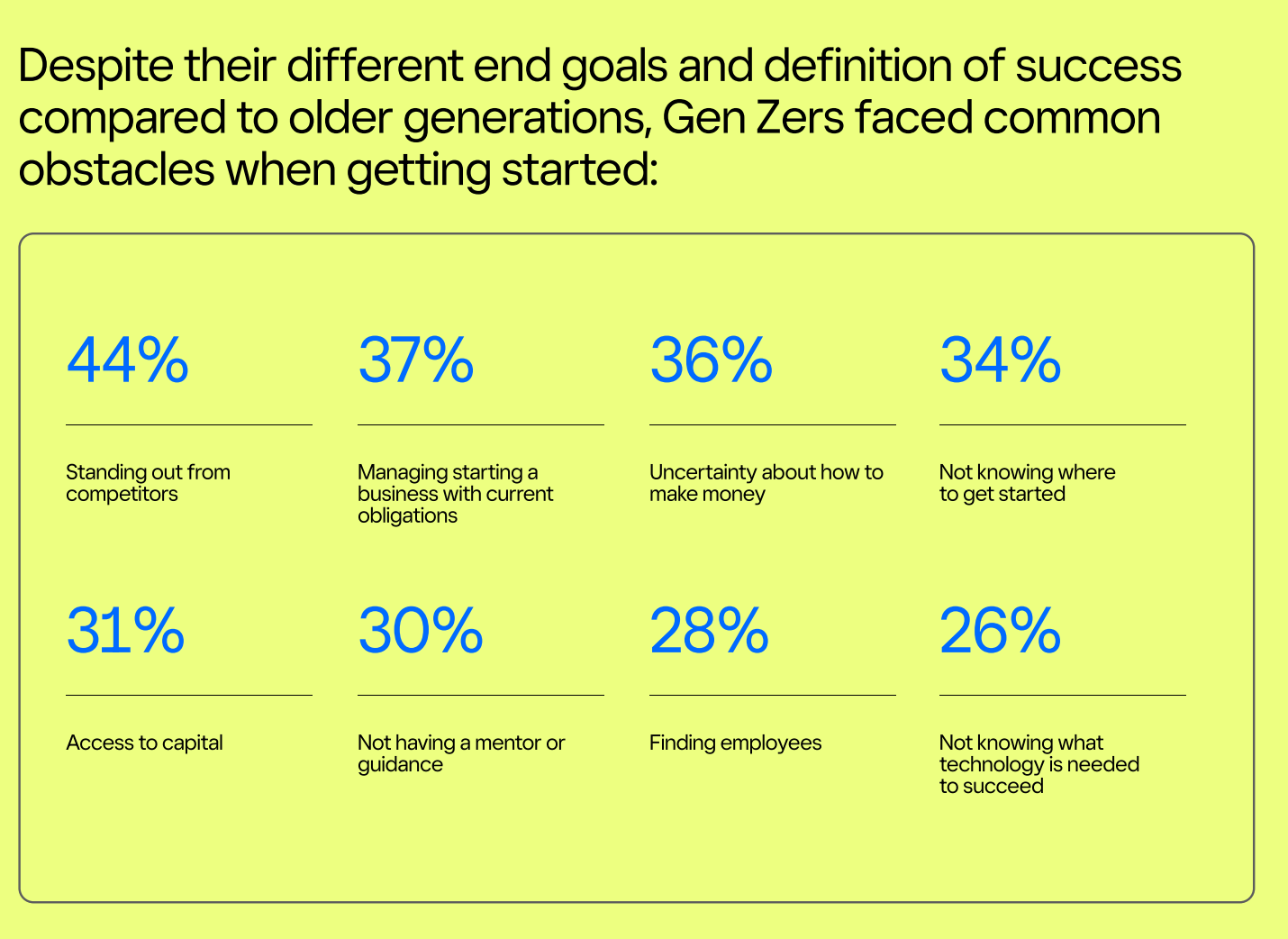
90% of Gen Z entrepreneurs who used their own savings as capital still expected to be a business owner in five years.
This was compared to 79% who got their start-up capital from somewhere else.
80% of Gen Z entrepreneurs started their business online or had a mobile component.
- 44% had a website.
- 41% operated through an online marketplace.
- 34% used an app or social media.
Along with an online presence, 46% of Gen Z entrepreneurs had a physical location.
Moreover, males were more likely to start their business with some type of physical presence (51%) compared to females (39%).
The top 5 obstacles Gen Z entrepreneurs faced included:
- Standing out from competitors - 44%
- Managing a business with current obligations - 37%
- Uncertainty about how to generate revenue - 36%
- Not knowing where to get started - 34%
- Access to capital - 31%
94% of Gen Z entrepreneurs felt they didn't have the skills to handle financial tasks such as taxes, day-to-day expenses, long-term budgeting, and investing in their business.
Additionally, these young entrepreneurs rated lower taxes (46%), affordable housing (42%), and Universal basic income (35%) as the economic policies that would be most beneficial to their operations.
Solo Entrepreneurship Statistics
Across all income levels in the GEM report, 50% of entrepreneurs were solo entrepreneurs.
Solo entrepreneurs or those with no employees, exceeded that of entrepreneurs employing 5 or more people. Women were also 36% more likely than men to be solopreneurs.
Rates of solo entrepreneurship hit highs of 84% in 2020, up from around 76% in 199721.
Additionally, 56% of solopreneurs started their business after 2020, with inflation being the biggest motivator.
50% of solopreneurs in 2024 said digital technology made starting a business possible.
In addition, solopreneurs stated that social media had the highest potential to increase business growth. 76% of solopreneurs worked remotely at least some of the time. 34% worked from home and 50% used a dedicated work space. Meanwhile, 36% planned to expand physical locations.
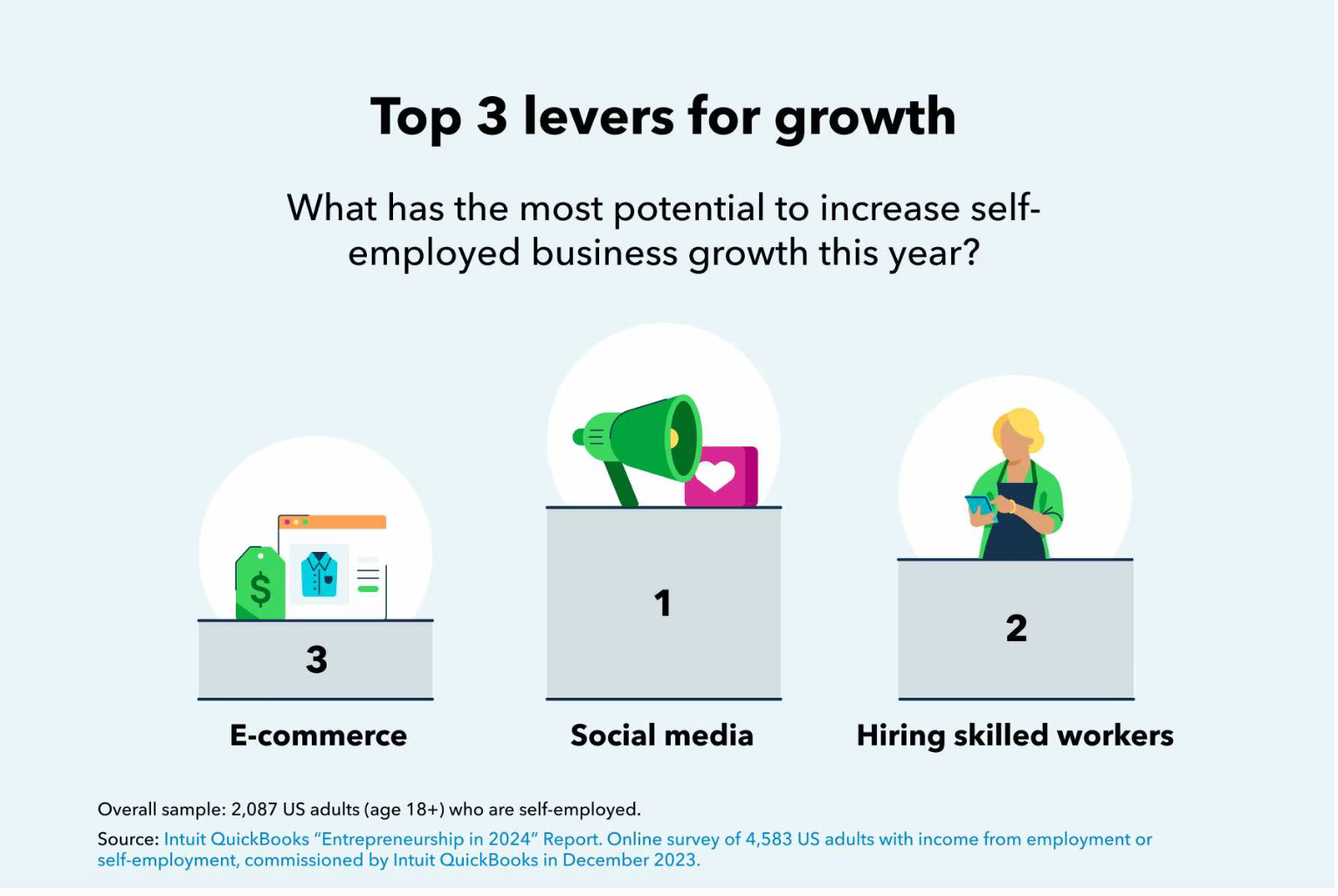
52% of solopreneurs chose entrepreneurship as they wanted to be their own boss.
36% chose entrepreneurship due to a lack of opportunities, while 33% ventured into it to find personal fulfillment.
33% of solopreneurs in 2024 used entrepreneurship to supplement their salaries.
Solopreneurs said they needed to earn an average of $219,000 in 2024 to feel successful.
Of those who held down day jobs, 49% said they would need to earn at least $100,000 per year from their ventures before they considered quitting.
42% of solopreneurs made increasing revenue their primary goal in 2024.
In addition, 15% planned to maintain their current revenue, while 13% planned to get financing to unlock growth.
80% of solopreneurs said they interacted with or found customers online.
As a result, 62% of solopreneurs planned to invest in ecommerce in 2024, while only 36% planned to invest in physical locations.
35% of solopreneurs rated their stress levels as high compared to 26% of employer entrepreneurs.
Similarly, 44% of entrepreneurs compared to 35% of solopreneurs rated their satisfaction levels as high. As a result, 66% of solopreneurs planned to enlist the help of freelancers or contractors, while 60% planned to hire at least one employee or contractor in 2024.
Social Entrepreneurship Statistics
As of 2024, there were 10 million social enterprises, accounting for more than 3% of businesses worldwide.
The highest number of social enterprises were found in India (2 million), China (1.75 million), and the US (1.3 million)22.
There were an estimated 30 million social entrepreneurs worldwide in 2024.
Social entrepreneurs place purpose over profit and remain a critical driver of wealth, sustainable development, and economic resilience.
Social entrepreneurship generated around $2 trillion in revenue annually and created close to 200 million jobs.
Accounting for 2% of global GDP, social entrepreneurship was larger than the $1.79 trillion apparel industry and almost twice the size of the $1.01 trillion advertising industry in 2024.
Social enterprises required 75% of their total turnover in funding in 2024.
This amounted to an estimated requirement of $1.13 trillion in global financing to remain operational and impactful.
As of 2024, 50% of social enterprises globally were women-led, compared to 20% of regular businesses.
Additionally, social enterprises led by women increased by 10% between 2015 and 2021.
Begin Your Entrepreneurial Journey With Whop

If you're ready to start your journey as an entrepreneur, then you're in the right place. Here on Whop we empower you to start your own online business. Whether you're selling online courses, creating and selling ebooks, sharing your sports picks with a paying community or leading online fitness classes, you can do it all with Whop.
Your whop is your very own online business hub. Your whop is free to create, and you can customize it using your whop apps, which are the features you add to your whop. You can do anything from hosting a community, to running giveaways, affiliate marketing, and live video calls - all within your whop. Plus, you can charge for access to part or all of your whop through one-off payments, subscriptions, and buy-now-pay-later schedules.
Whop only takes an industry-leading 3% of your sales and no ongoing platform costs, so you get to keep a huge 97% of your earnings. There's nothing to lose - launch your online business today.
FAQs
What percentage of the world is an entrepreneur?
Entrepreneurs make up 8% of the world's population.
Which country has the highest rate of entrepreneurship?
As of 2024, the United States is considered the most entrepreneurial country.
What is the most common type of entrepreneurship?
Small business entrepreneurship is the most common type of entrepreneurship, accounting for 90% of all companies worldwide.





